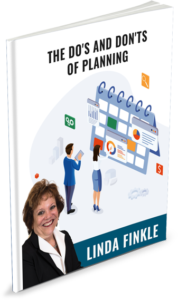As executives and business owners, planning is a natural part of your business life. You plan for product rollouts, employee growth, projects, revenues, and more, but don’t necessarily look at planning as a process.
The value of planning isn’t just about the result, The Plan (the document) itself. Planning is about the process, the act of thinking about your company, and your goals, and how you’re going to get there. There isn’t a right way or a wrong way to plan, but there are better ways than others to think about planning.
What’s involved in a plan, then?
A plan considers your goals for your company and the actions you’ll carry out to reach those goals. While you want to make sure those goals are realistic (are you really going to roll out two new products next year, or can you really go from revenues of $1 million to $3 million in one year?), at the same time, you never know what you could achieve without a plan. You may be successful without one, but you may never know what other possibilities there were beyond your current success without a plan.
Part of the value in planning is that it provides evidence to you as to how and why you are successful. Often companies are very successful, but they can’t really tell you why. And while we don’t want to take away the magic by analyzing away, we can learn to clarify who we are that makes us successful and build that into the plan.
So, you have a plan. Now what?
Does it sit on your computer never to be looked at again? Absolutely not. Your plan is a living document and needs constant attention. This means that you need to look at it often (monthly at least) to determine if you are on track to meet your goals. If you find you’re not on track, that’s okay. The goal of the plan is not to have something etched in stone, but something that develops as your company does.
What happens if a new opportunity arises that you didn’t plan for or hadn’t taken into account? If you use the plan you developed as the yardstick to measure the current opportunity, you might determine that even though it’s a great opportunity, you as a company (or as an individual) may not be ready at this time. Using the existing plan helps you make the critical judgments all executives need to make as conditions change.
A word of caution about changing the plan.
Usually, the problem with changing the plan is not the changes themselves; it’s that we make changes without considering the current plan and the assessment that goes with it. We plan, we create goals and actions to meet those goals, and we take into consideration the business and the individuals as part of that plan. If we change the plan, then we could go off course from our original plan without any thought or assessment of this new opportunity against our original goals. Does this new opportunity get us where we want to be, or does it change our direction? If we change direction, is that a good thing or bad? Do we have the resources to implement this new change? What do we need to shift around, and how does this new opportunity impact other parts of the original plan (training/staffing issues, for example).
What we most often do is simply jump into this new area without the careful consideration we gave the original plan. So we haven’t thought of what if’s and how to’s. We don’t consider the implications to other parts of the plan and organization. A change in one part always affects some other parts. We can’t simply decide to change something and incorporate the change into the plan.
You’ll find that as you review your plan (monthly at least, remember?), assess, make changes, and incorporate new opportunities, that you are fully entrenched in the process of planning. You’ll find as you go along that each year your plan will be more useful as a tool to assist with making business decisions based on information and facts. Ultimately the information one gleans month after month, year after year is what is powerful, the information provides us the power to make informed choices for our department, our business, and ourselves.
What else you need to know about planning
1. Involve others in the planning process. A plan is that much stronger when you have multiple viewpoints and input. Also, share the plan. Employees and staff will buy-in to the actions when they understand the goals and the plan.
2. Do what you’re passionate about. If you create a plan around what you love and love doing, the passion will come through in both the plan and the implementation.
3. Don’t make planning a harsh ‘should’ in your life. See it as an opportunity to create what you want for your life, professional, and personal.
4. Be kind to yourself. This isn’t about pointing to the cracks in your company; it’s about understanding your capabilities and building a plan that plays to those capabilities. And it’s about finding a workaround for those areas of cracks.
5. Planning isn’t only for executives. Salespeople should develop a plan for themselves. Anyone who will be leading projects or wants to take on additional responsibilities would be well served by creating a plan.
At the end of the day, you get so much more than just The Plan. You have a process for your business, a litmus test for all your actions, and a road map to your goals, whether those goals are to reach a certain revenue point, sell the company, turn over management, or whatever designs for your business you might have.
Whether planning is new to you, or you’ve done it for years there is always something new you can learn about planning.
Download our free guide The Do’s and Don’ts of Planning. We’ve outlined 10 considerations for each that will help you as you do your next plan. Click the link below.









